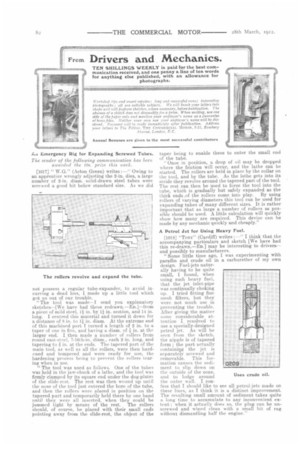Fr cm
Page 18

If you've noticed an error in this article please click here to report it so we can fix it.
Drivers and Mechanics.
TEN SHILLINGS WEEKLY is paid for the best communication received, and one penny a line of ten words for anything else published, with an allowance for photographs.
Trorkshop tips and smart repairs; long and successful rues; interesting photographs ; all are suitable subjects. We will knock your letters into shape and will pretare sketches, where necessary, beforePublication, The absence of a sketch does not disqualify for a prize. When tr.n Ulm, use one side of the paper only and mention your employer's name as a guarantee of bona fides. Neither sour own NOP your employer's name will be disclosed. Payment will he made immediately after publication. Address your letters to The Editor, Tan COMMERCIAL MoToR, 7-15, Rosebery
Avenue, London, E.C. _ Annul Bonuses are given to the most successtui contributors
ha Emergency Rig for Expanding Screwed Tubes.
The sender of the following communication has been awarded the Ws. prize this week.
[1017] " W.G." (Acton Green) writes :—" Owing to an apprentice wrongly adjusting the 2-in, dies, a large number of 2-in. diam. solid-drawn steel tubes were screwed a good bit below standard size. As we did
not possess a regular tube-expander, to avoid incurring a dead loss, I made up a little tool which got us out of our trouble.
"The tool was made—I send you explanatory sketches—[We have had these redrawn.—ED.]—from a piece of mild steel, i in. by 1t in. section, and 14 in. long. I centred this material and turned it down for a distance of 8 in. to 11 in. diam. At the extreme end of this machined part I turned a length of 2 in. to a taper of one in five, and having a diam. of in. at the larger end. I then made a number of rollers from round cast-steel, 7-16th-in. diam., each 2-in, long, and tapering to in. at the ends. The tapered part of the main tool, as well as all the rollers, were then hardened and tempered and were ready for use, the hardening process being to prevent the rollers tearing when in use,
"The tool was used as follows. One of the tubes was held in the jaw-chuck of a lathe, and the tool was firmly clamped by its square end under the dog-plates of the slide-rest. The rest was then wound up until the nose of the tool just entered the bore of the tube, and then the rollers were placed in position on the tapered part and temporarily held there by one hand until they were all inserted, when they could be jammed tight by means of the rest. The rollers should, of course, be placed with their small ends pointing away from the slide-rest, the object of the taper being to enable these to enter the small end of the tube.
" Once in position, a drop of oil may be dropped where the friction will occur, and the lathe can be started. The rollers are held in place by the collar on the tool, and by the tube. As the lathe gets into its stride they revolve around the tapered part of the tool. The rest can then be used to force the tool into the tube, which is gradually but safely expanded as the thick ends of the rollers come into play. By using rollers of varying diameters this tool can be used for expanding tubes of many different sizes. It is rather important that as large a number of rollers as possible should be used. A little calculation will quickly show how many are required. This device can be made by any mechanic quickly and cheaply."
A Petrol Jet for Using Heavy Fuel.
[1018] "Tony" (Cardiff) writes :---" I think that the accompanying particulars and sketch [We have had this re-drawn.—En.] may be interesting to drivers— and possibly to manufacturers.
"Some little tune ago, I was experimenting with paraffin and crude oil in a carburetter of my own design. Fuel-jets naturally having to be quite small, I found, when using such heavy fuel, that the jet inlet-pipe was continually choking up. I tried fitting fine mesh filters, but they were not much use in preventing the trouble. After giving the matter some considerable attention I resolved to use a specially-designed petrol jet.. As will be seen from the sketch, the nipple is of tapered form ; the part actually containing the jet is separately screwed and removable. This formation causes the sediment to slip down on the outside of. the cone, and to lodge around the outer wall. I confess that I should like to see all petrol-jets made on these lines, as I think it is a distinct improvement. The resulting small amount of sediment takes quite a long time to accumulate to any inconvenient extent ; when it actually does so, the plug can be unscrewed and wiped clean with a small bit of rag without dismantling half the engine."
Uses crude oil.




















